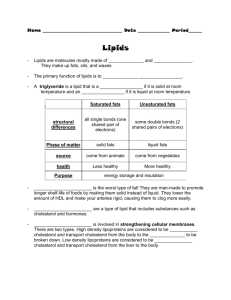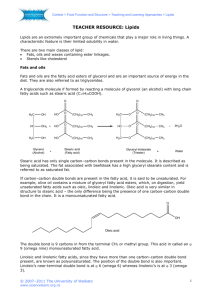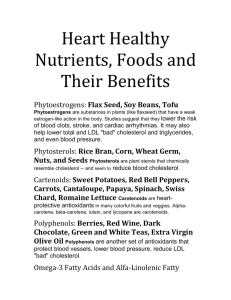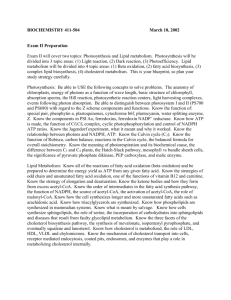Hydrolysis
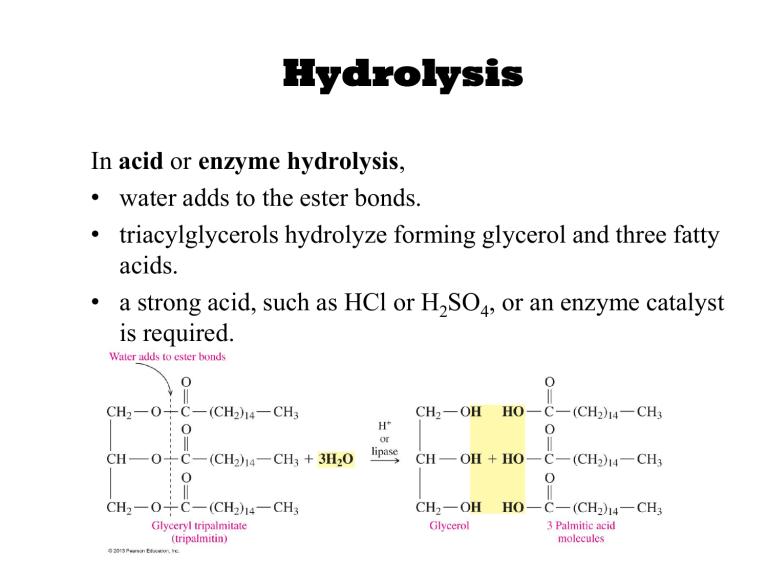
Hydrolysis
In acid or enzyme hydrolysis ,
• water adds to the ester bonds.
• triacylglycerols hydrolyze forming glycerol and three fatty acids.
• a strong acid, such as HCl or H
2
SO
4
, or an enzyme catalyst is required.
Base Hydrolysis (Saponification )
In base hydrolysis (saponification) ,
• a triacylglycerol reacts with heat and a strong base.
• a triacylglycerol splits into glycerol and the salts of fatty acids (soap).
• a solid soap that can be molded into a desired shape is produced when NaOH is used.
• a softer, liquid soap is produced when KOH is used.
• polyunsaturated oils produce softer soaps.
Saponification
Fat or oil + strong base glycerol + salts of fatty acids (soap)
For Lab Today
http://www.ediblegeography.com/multifunctional-desserts/
For Lab Today
• the cottonseed oil contains:
– 50% linoleate
–
30% oleate
–
20% palmitate
Summary of Organic and Lipid
Reactions
Phosphoric Acid
•
Has a structure similar to carboxylic acid:
O
R C OH
O
HO P
OH
OH carboxylic acid phosphoric acid
O
HO P
OH
OH + H-O-CH
2
CH
3
H + , heat phosphoric acid methanol
O
HO-P-O-CH
2
CH
3
OH methyl ethanoate
+ H-O-H
Glycerophospholipids
Glycerophospholipids , the most abundant lipids in cell membranes, contain
•
two fatty acids, which form ester bonds with the first and second hydroxyl group of glycerol.
•
a third hydroxyl group, which forms an ester with phosphoric acid, which then forms another phosphoester bond with an amino alcohol.
Insert picture of glycerophospholipid pg 618
Glycerophospholipids Contain
Amino Alcohols.
•
Three amino alcohols found in glycerophospholipids are choline, serine, and ethanolamine.
•
In the body, at a physiological pH of 7.4, these amino alcohols are ionized.
Insert structures of amino alcohols pg 618 bottom
Glycerophospholipids are Polar and Nonpolar.
Glycerophospholipids have
• both polar and nonpolar regions that allow them to interact with polar and nonpolar substances.
• an ionized amino alcohol and phosphate portion, called
―the head,‖ which is polar and strongly attracted to water.
• a hydrocarbon chain known as ―the tail,‖ which is soluble in nonpolar substances.
Formation of
Glycerophospholipids
The formation of a glycerophospholipid occurs when ester bonds form between glycerol and two fatty acids, and two phosphoester bonds form between phosphoric acid and an ionized amino alcohol and glycerol, such as palmitic acid.
Components of
Glycerophospholipids
The components of a glycerophospholipid are choline, phosphoric acid, glycerol, and two fatty acids.
Insert structure from figure 17.6a
Components of
Glycerophospholipids
In a glycerophospholipid, a polar ―head‖ contains the ionized amino alcohol and phosphate, while the hydrocarbon chains of two fatty acids make up the nonpolar ―tails.‖
Learning Check
Identify the components of glycerophospholipid.
O
║
CH
2
—O—C— (CH
2
)
16
—CH
3
O
║
CH
2
—O—C— (CH
2
)
16
—CH
3
+
O NH
3
║ │
CH
2
—O—P—O—CH
2
—CH−COO –
│
O
–
Solution
Identify the components and type of glycerophospholipid.
O
║
CH
2
—O—C— (CH
2
)
16
—CH
3
O
║
CH
2
—O—C— (CH
2
)
16
—CH
3
+
O NH
3
║ │
CH
2
—O—P—O—CH
│ Serine
O
–
2
—CH−COO –
2 Stearic acids
Phosphate Amino alcohol
Steroid Nucleus
Steroid molecules contain a steroid nucleus with
•
3 cyclohexane rings,
•
1 cyclopentane ring,
• no fatty acids, and
• a total of four rings A, B, C, D.
The steroid nucleus is numbered from the carbon atoms in ring A to two methyl groups at 18 and 19.
Cholesterol
Cholesterol
• is the most important and abundant steroid in the body.
• is a sterol because it contains an oxygen atom as a hydroxyl group, –OH on carbon 3.
• has a double bond between carbon 5 and carbon 6.
• has methyl –CH
3
groups, at carbon 10 and 13.
• has a carbon chain at carbon 17.
Cholesterol
Cholesterol is a component of cellular membranes, myelin sheaths, and brain and nerve tissues.
Cholesterol in the Body
A normal, open artery.
Cholesterol in the body
• is obtained from meats, milk, and eggs and synthesized in the liver.
• clogs arteries when high levels form plaque.
An artery clogged by cholesterol plaque
Cholesterol in Foods
A typical American diet includes 400–500 mg of cholesterol per day.
The American Heart Association has recommended no more than 300 mg of cholesterol per day.
Saturated fats in the diet may stimulate the production of cholesterol by the liver.
Learning Check
Match the components of the cholesterol molecule with each of the following:
alkyl chain
steroid nucleus
hydroxyl group
methyl group
D
CH
3
CH
3
B
CH
3
CH
3
CH
3
A
HO
C
Solution
Match the components of the cholesterol molecule with each of the following:
steroid nucleus
D
CH
3
CH
3
B
CH
3
CH
3
CH
3
A
HO
C
Bile Salts
Bile salts
• are synthesized from cholesterol in the liver.
• are stored in the gallbladder and secreted into the small intestine.
• have a polar and a nonpolar region.
• help in the absorption of cholesterol into the intestinal mucosa.
Sodium Glycocholate, a Bile Salt
Polar region
Nonpolar region
Gallstones
Gallstones are
• formed when large amounts of cholesterol accumulate in the gallbladder.
• composed of almost 100% cholesterol, with some calcium salts, fatty acids, and glycerophospholipids.
Hydrophobic Lipids and Biology
1.
Lipid molecules will aggregate to minimize their contact with water.
2.
Depending on the general shape of the lipid molecule, different-shaped aggregates form.
3.
Smaller lipids like fatty acids will come together to make micelles.
Fatty acids
Complex lipids
If the fatty acid is shown as depicted below, then a micelle can be visualized as….
CH
3
(CH
2
) n
COOH hydrophobic hydrophilic
Hydrophobic
Hydrophilic
Cutaway of a micelle with the hydrophobic chains extend to the center of this aggregate and hydrophilic groups to the outside
More complex lipids such as phospholipids and sphingolipids are shaped differently than fatty acids and will aggregate differently in water solutions. They form liposomes…… hydrophobic hydrophilic
Liposomes: Form from Phospholipids andSphingolipids
CH
3
(CH
2
)
10
NH
O
H
3
C
N
H
3
C
CH
3
O
O
O
P
O
OH
(CH
2
)
12
CH
3
CH
3
O
O
O
O O
P
O
O
O
CH
3
A cutaway of a single liposome with the bilayer shell and the water solution core .
Lipoproteins
Lipoproteins
• are spherical particles with an outer surface of polar proteins and glycerophospholipids that surround hundreds of nonpolar molecules of triacylglycerols and cholesteryl esters.
• combine lipids with proteins and phospholipids.
• are soluble in water because the surface consists of polar lipids.
Lipoproteins
A spherical lipoprotein particle surrounds nonpolar lipids with polar lipids and protein for transport to body cells.
Types of Lipoproteins
Lipoproteins differ in density, composition, and function and include
• chylomicrons, very low-density lipoprotein (VLDLs);
• low-density lipoproteins (LDLs), which carry cholesterol to the tissues; and
• high-density lipoproteins (HDLs) that pick up cholesterol from the tissues and carry it to the liver.
LDLs
LDLs
• transport cholesterol to tissues where it can be used for synthesis of cell membranes and steroid hormones.
• deposit cholesterol in the arteries in the form of plaque when cholesterol levels exceed levels needed by tissues.
• called ―bad‖ cholesterol for their contribution to heart disease.
HDLs
HDLs
• are more dense than LDLs due to the increased amount of protein present.
• pick up cholesterol from the tissues and carry it to the liver, where it can be converted to bile salts, which are eliminated from the body,
• are called ―good‖ cholesterol.
VLDLs
VLDLs carry the triacylglycerols synthesized in the liver to the adipose tissues for storage.
Insert fig 17.10 pg 626
Lipid distribution system through the bloodstream
•
VLDL : v ery l ow d ensity l ipoprotein are transport vehicles for cholesterol and lipids. Prepared by liver to move cholesterol and lipids around the body.
•
LDL : smaller version of VLDL to move cholesterol and lipids to peripheral tissues (bad guy)
•
HDL : high density lipoprotein is the bloodstreams scavenger or cholesterol vacuum cleaner (good guy)
Lipid Panel
A lipid panel is a blood test that measures serum lipid levels including
• cholesterol
• triglycerides
• high-density lipoprotein (HDL)
• low-density lipoprotein (LDL)
The results of a lipid panel are used to evaluate a patient’s risk of heart disease.
Lipid Panel
Steroid Hormones
Steroid hormones
• are chemical messengers in cells.
• are produced from cholesterol.
• include sex hormones, such as androgens (testosterone) in males and estrogens (estradiol) in females.
Steroid Hormones
Learning Check
Identify each of the following as a steroid, triacylglycerol, phospholipid, or sphingolipid.
A. cholesterol
B. glycerol, 2 fatty acids, phosphate, and choline
C. glyceryl tristearate
D. bile salts
E. lipids in plasma membranes
Solution
A. cholesterol
B. glycerol, 2 fatty acids, phosphate, and choline
C. glyceryl tristearate
D. bile salts
E. lipids in plasma membranes steroid phospholipid triacylglycerol steroid phospholipid
Cell Membranes
Cell membranes have a lipid bilayer that
• separates cellular contents from the external environment.
• contains two layers of glycerophospholipids arranged with their hydrophilic heads at the outer and inner membrane surfaces and their hydrophobic tails in the center.
Fluid Mosaic Model of Cell
Membranes
The lipid bilayer
• contains proteins, carbohydrates, and cholesterol.
• has unsaturated fatty acids that make cell membranes fluid-like rather than rigid.
• has proteins and carbohydrates on the surface that communicate with hormones and neurotransmitters.
Fluid Mosaic Model
Transport Pathways Through
Cell Membranes
The transport of substances through cell membranes involves
• diffusion (passive transport) , which moves particles from a higher to a lower concentration;
• facilitated transport , which uses protein channels to increase the rate of diffusion; and
• active transport , which moves ions against a concentration gradient.
Transport Pathways Through
Cell Membranes
Learning Check
What is the transport of particles across a cell membrane from high concentration to low concentration called?
A. facilitated transport
B. diffusion (passive transport)
C. active transport
Solution
What is the transport of particles across a cell membrane from high concentration to low concentration called?
A. facilitated transport
B. diffusion (passive transport)
C. active transport



